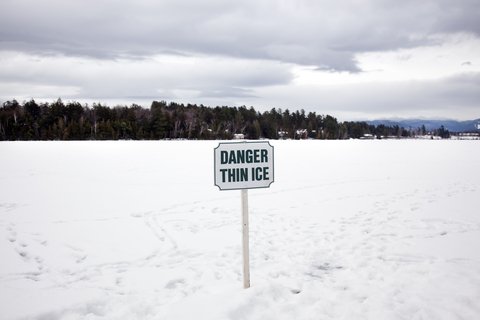The snow is falling. Lakes and rivers are freezing up. Winter can be a beautiful time of year, but it’s also filled with unforeseen dangers, chief among them is falling through the ice.
It doesn’t take long in frigid water for your muscles to tighten, your lungs to constrict and your body to succumb to hypothermia. If you don’t have an ice axe or partner to help you out, rescuing yourself after a fall through ice can pose some serious challenges.
Every year it’s estimated that nearly 8,000 people die from drowning. In attempt to avoid more tragedies, the United States Swim School Association has created the following list of what to do if you fall through a sheet of ice.
Brace Yourself
This may be difficult to do at first but due to the immediate change in body temperature and shock from the cold water, the body’s immediate reaction is going to be to gasp for air and hyperventilate. Breathing in the freezing water increases the chances of drowning.
Keep Calm
Do not flail your arms; this will release more body heat. The body loses 32 times more heat in cold water than in cold air. Panicking will do nothing, keep your head above the water, grab onto the ice in the direction you came from. This ice should be strong enough to help you out of the water.
Do Not Undress Winter Clothes
Keep winter clothing on while in the water, it will not drag you down. It will help keep in body heat and any air inside the clothing will help you float.
Get Horizontal
Once you’ve gotten most of your upper body out of the water, kick your legs as strongly as possible in hopes of getting yourself out of the water and onto the ice.
Roll Onto The Ice
Do not stand up, roll over the ice once you’re out to help prevent more cracks in the ice and from falling in again. Always stay off ice that’s only 3 inches thick or less.
Retrace Your Steps
Once out and far enough away from the hole, trace your footsteps back to safety. Take it slow because your body is still dealing with the affects of the freezing water.
Throw, Don’t Go
Never enter the water to rescue someone. If someone is there to help you it is safer for that person to throw a lifesaving device, branch, coat, or rope into the water, wait until you grab hold and then tow you to safety. Otherwise you could both end up in the water.
Get Warm
Once out of the water seek medical attention to bring body temperature back to normal.
To find a USSSA affiliated swim school near you, or for details on becoming a member of the nation’s leading swim school organization visit USswimschools.org.
Photo credit: Dreamstime








